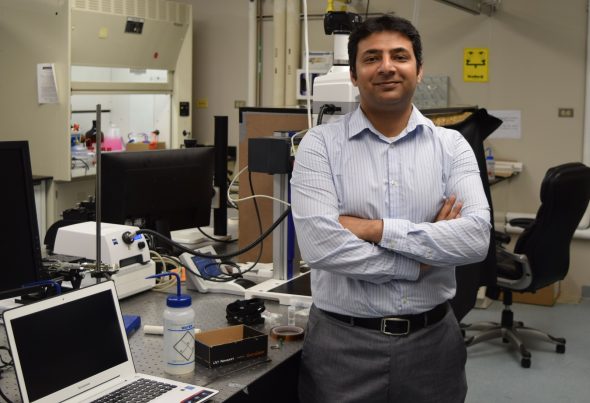Engineering professor receives prestigious NSF CAREER Award for condensation research

By David Staudacher
Sushant Anand, assistant professor of mechanical and industrial engineering, has been selected to receive the prestigious National Science Foundation Faculty Early Career (NSF CAREER) Award, which supports early career faculty who have the potential to serve as academic role models in integrating research and education and to lead advances in the missions of their department and organization. The award is the most prestigious honor for up-and-coming researchers in science and engineering.
The CAREER award provides five years of funding to help lay the foundation for a faculty member’s future research. Anand will receive $529,561 to study “Condensation-Driven Phase-Transitioning Surfaces.”
“The goal of this research is to understand condensation on a class of existing materials that can undergo phase-transition due to condensation itself,” Anand said. “Such materials potentially possess several beneficial attributes of solid and liquid surfaces that could be the key to overcome many of the challenges faced by the existing superhydrophobic or liquid infused surfaces.”
His preliminary work has been focused on water for applications like water harvesting, where water is collected directly from the air. To do this efficiently, a special surface is needed.
“To increase the efficiency of water harvesting, you need to increase the efficiency of water drop nucleation so more water drops will form,” he said. “At the same time, you need to make sure the droplets leave the surface faster so you can collect more. For some time, I’ve been working on these surfaces called lubricant-infused surfaces.
“The problem with these surfaces is extending their durability for considerable time is very challenging. For a variety of reasons, they lose the lubricant over a period of time, especially during condensation. These are lubricants that are immiscible with water, and small amounts of liquid are sheared off as water flows through them.
“To counter that problem, I have been working on an alternate concept called condensation-driven phase-transitioning surfaces,” Anand continued. “This concept is based on phase change materials that have a melting point of 6 degrees and so when you cool them down below their freezing temperature, they freeze. But when you condense water on it, the water drops show really unusual droplet motion that is ascribed to the melting of the localized surface around droplets due to the release of heat during condensation. This is a very interesting behavior and I wanted to investigate it further.”
Anand and his team found that if they took the same material and cooled down considerably (to -15 oC, for example), the drops displayed the same behavior. This came as a surprise because it implied that the materials are somehow melting the water drops, and the region around the water drops is melting, which can only happen if there is a heat that goes into the substrate to cause a 10-to-20-degree jump. The team tested some other materials and found similar behavior with varying degree of droplet motion on them.
“We saw large temperature jumps and it was entirely unexpected,” he said. “For the last few years, we have been working on trying to figure out the dynamics. Where it happens. Where it doesn’t happen. What are the factors that can compromise this behavior? Trying to understand that became the topic of my NSF CAREER award.”
Anand proposed using this concept and materials to replace the existing liquid-infused surfaces. You could have a composite solid surface made of solid texture and these materials infused within the texture and operate them below their melting point so that the entire surface remains solid. However, when water drops condense on them they will become liquid around the drops.
“So, you get the advantage of the high mobility of the drops without having the problems of the shear driven or drainage problems that are typically related with the liquid infused surfaces,” Anand said. “These can be applied on buildings, in power plants on the condensers, or the water harvesting panels. They can be used in many different applications.”
Anand and his team figured out that the melting has to happen close to the contact line and, somehow, that melting is preventing the whole droplet to transition from the ice phase.
“We still don’t know a lot about these surfaces,” he said. “We don’t know how this melting is taking place. We don’t really know how the melting changes over a period of time. And figuring that out is part of the research.”
“We proposed a way to actually find out for the first time the nanoscale temperatures below the drops,” he added. “This is a very challenging problem to solve, but that is what makes the research so much fun. We have a plan to do that, and if successful it will be first of any such kind of measurement performed.”
Anand received his Ph.D. in mechanical engineering from the University of Cincinnati, Ohio, in 2011, and did his postdoctoral work at MIT. He joined the MIE department at UIC in 2015. Learn more about his research and accomplishments at https://anand.lab.uic.edu.
